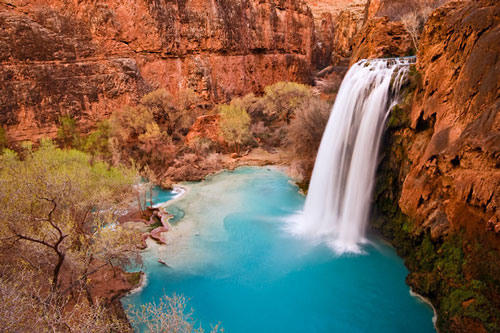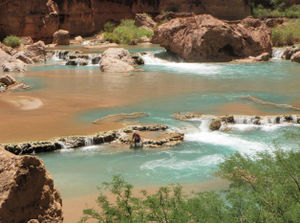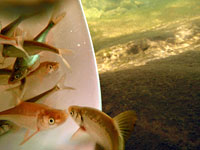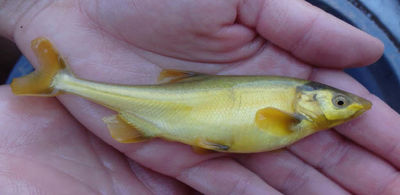Chute Falls Translocation (Little Colorado River)
YouTube: Humpback Chub Translocation in the Little Colorado River
Background [1]
- Prior to translocations: no HBC above Chute Falls (fish barrier or high CO2 levels). Since 2003, six chub have been documented ascending Chute Falls on their own accord. [2]
- High productivity and higher winter water temperatures than the lower LCR should equal higher growth rates and faster maturity
- Translocations began 2003
- ~3,106 juvenile humpback chub have been translocated from the lower reaches of the LCR to upstream of Chute Falls (2015) [3]
- Annual Monitoring – hoop nets surveys in May or June
Objectives
2003-2005 [4]
- Determine if HBC can survive and remain above Chute Falls: yes, translocated fish had higher survival than Coggins et al. 2006 estimate. Good retention during most years but populations is susceptible to stochastic events (e.g. 2010 flood)
- Determine if HBC grow (given increased food availability, but potential detrimental impacts from CO2):
- By the 1st ensuing spring since being released 16% of age-1 translocated chub had achieved adult size (>200 mm TL).
- By the 2nd ensuing spring since being released 96% of age-2 chub had achieved adult size. [5]
- Determine if HBC can recruit to adulthood: yes
- Determine if HBC spawning population will develop: tbd
2006-Present [6]
- Conduct mark/recapture population estimates – 2 reaches (>CF and LA to CF) to determine:
- Migration patterns: Chute is not a complete barrier to chub moving upstream, movement throughout, including to the mainstem
- Growth rates: higher growth rates than fish lower in the LCR
- Spawning activity: ripe fish and YOY fish found above Chute in 2007
- Assess overall benefit to LCR HBC: Appears to be one of few tools available to directly increase adult population if needed in future.
Translocations are relatively easy and inexpensive beneficial conservation actions compared to other options that may be much more expensive and politically difficult to implement. [7]
Havasu Creek Translocations
Included as a Conservation measure in the 2008 and 2011 Biological Opinions
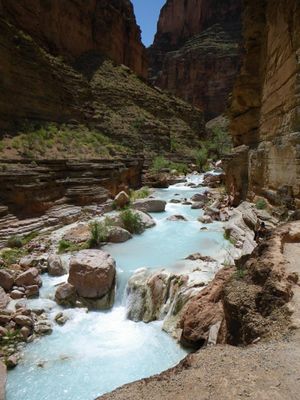 Falls in Lower Havasu Creek Background
Monitor translocated Humpback Chub and fish community in creeks and nearby Colorado River mainstem
- Survey twice annually
- Survey the mainstem Colorado River annually- GCMRC/FWS & NPS
- Remove non-native fish captured during surveys
Objectives
- Establishment of a second spawning and recruiting population in the mainstem or tributary
- Sufficient survival and growth to provide a rearing (“grow-out”) opportunity to augment the local mainstem aggregation
- Maintain at least 20% of HBC to survive in the creek or adjacent mainstem aggregation for at least one year [8]
Metrics
- Retention of translocated humpback chub over the first year
- Similar or increased juvenile survival relative to the Little Colorado River and mainstem Colorado River near the Little Colorado River inflow
- Similar or increased growth rates relative to the Little Colorado River and mainstem Colorado River near the Little Colorado River inflow
- Contribution to and retention of translocated fish to an adjacent mainstem aggregation
- Evidence of successful reproduction (presence of larval or young-of-year fish)
- Evidence of recruitment to mature size [9]
Project History
Translocated 1650 humpback chub (total):
- 2011: 243
- 2012: 298
- 2013: 300
- 2014: 509
- 2015: 300 [10]
Results
- Similar survival relative to Little Colorado River and nearby mainstem (which is higher, Yackulic et al. 2014)
- Growth rates as high or higher than the LCR
- Evidence of natural reproduction and recruitment since 2013
Next Steps
Triggers for additional HBC translocations to maintain genetic diversity (see FWS 2010)
- Minimum of 200 adults maintained
- At least 10 migrants/ generation (or add additional 10)
- 45-1000 released over a generation (10 years) [11]
Shinumo Creek Translocations [12]
Included as a Conservation measure in the 2008 and 2011 Biological Opinions
Background
 Falls at the mouth of Shinumo Creek  PIT antenna install in Shinumo Creek Grand Canyon National Park translocations (more information)
Objectives
- Primary: Develop second spawning population
- Provide rearing (grow-out) opportunities, augmentation of mainstem aggregations
Project History
Translocated 1,102 humpback chub (total):
- 2009: 302
- 2010: 300
- 2011: 300
- 2013: 200
June 2014 population estimate: ≈125 to 190 individuals (preliminary; all years represented)
Three HBC translocated to Shinumo Creek have been detected at the antenna array in the LCR [13]
Results
- Meeting Objectives for rearing/”grow-out”
- Annual growth greater than in the mainstem Colorado River but less than in the LCR 2 out of 3 years (2013-14 results pending)
- Large portion of mainstem captures at the mouth of Shinumo are translocated fish
- No reproduction (but fish were still young)
Galahad Point Fire – May-July 2014 [14]
Shinumo Creek flooding (containing ash) reported in July and August
- PIT tag antenna destroyed in July
- >99% decline in fish, overall
- High density of rainbow trout in Merlin Abyss Creek (½ mile of undamaged habitat)
- Bluehead sucker and humpback chub believed to be extirpated
- Significant channel alteration, pools filled
- 80-90% loss of riparian vegetation
Next Steps
- Remove remaining trout in Merlin Abyss
- Monitor habitat recovery
- In 3-5 years restore native fish community throughout watershed (humpback chub, speckled dace, bluehead sucker)
Bright Angel Creek Translocations
Background
Objectives
Project History
Results
Next Steps
- Implementation of an experimental translocation of Humpback Chub with associated monitoring – monitoring will include 2 netting excursions in spring and fall, similar to other NPS-led translocation projects (see Trammell et al. 2012);
- Installation of a PIT tag antenna array at the mouth of Bright Angel Creek to monitor outmigration of translocated Humpback Chub as well as to assist in the assessment of the impacts of monitoring and handling stress on movements of native fishes;
- Implementation of reduced nonnative mechanical removal, including the targeting of areas with high densities of Brown Trout – in 2018, an electrofishing pass may be conducted throughout the stream followed by additional passes in areas with high densities of trout;
- Continued monitoring of the impacts of electrofishing on native fish vital rates (survival, recruitment, etc.) – PIT tagging may be expanded to smaller size classes, as appropriate and in consideration of the health of the fish; and
- Continued consultation with Tribes, consistent with our MOA under Section 106 of the NHPA.
Beaver Falls Translocations (Havasu Creek) (proposed; 2016 Conservation Measure)
Mainstem Translocations in Western Grand Canyon (proposed)
Mainstem Translocations at the LCR (proposed; 2016 Conservation Measure)
|

